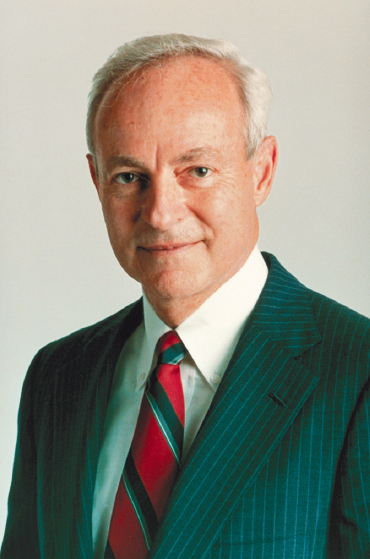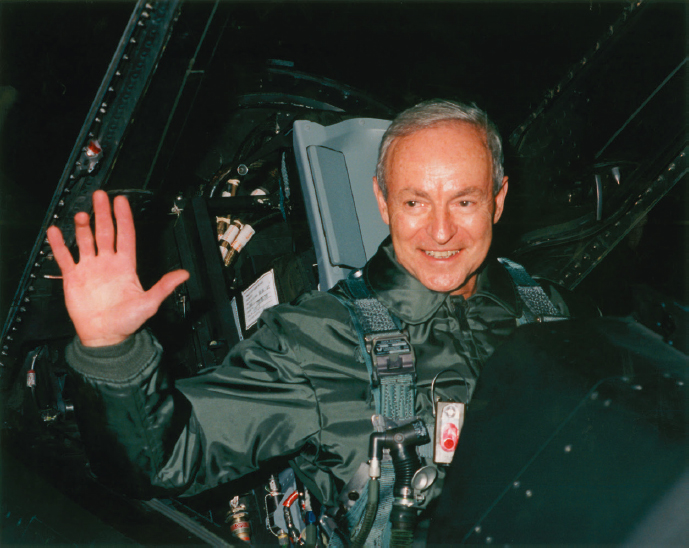

DANIEL M. TELLEP
1931–2020
Elected in 1979
“Pioneering theoretical, experimental, and design contributions in the development of reentry systems for US Fleet Ballistic Missiles.”
BY SHERMAN N. MULLIN
SUBMITTED BY THE NAE HOME SECRETARY
DANIEL MICHAEL TELLEP, retired first chair and chief executive officer of Lockheed Martin Corporation, died at his home in Saratoga, California, on Thanksgiving morning, November 26, 2020, a scant week after his 89th birthday.
He was born November 20, 1931, in the small coal mining town of Forest City, Pennsylvania, the son of John, a coal processor and later carpenter, and Mary, who worked for a thread company. Around 1940 the family moved to San Diego. Years later Dan remembered the wonderful experience of enjoying the California sunshine. He became a devoted Californian.
He graduated summa cum laude from the University of California, Berkeley, with a bachelor’s degree (1954) and stayed to get his master’s degree, both in mechanical engineering, the next year. He particularly appreciated gaining extensive mathematical knowledge and perceiving its engineering utility. Years later, after a successful career, he happily endowed an engineering professorship at his alma mater.
He started his engineering career in 1955 as one of the first 200 employees of the newly formed Missile Systems Division
___________________
Readers are also referred to the family’s delightful, illustrated tribute, available at https://www.lockheedmartin.com/content/dam/lockheedmartin/eo/photo/news/features/tellep/daniel-m-tellep-family-tribute.pdf.
of Lockheed Aircraft Corporation in Van Nuys. He rapidly became known to Willis Hawkins, the director of engineering, who became a mentor and supporter. The division soon evolved into Lockheed Missiles and Space Company, with a large new plant in Sunnyvale and a research and development laboratory in Palo Alto. Over the next 3 decades the company became Lockheed’s largest, most profitable operating division, and the engineering and management career of hard-working, self-confident Dan Tellep flourished.
In 1955 the US Navy had selected Lockheed to design and produce a submarine-launched, solid-rocket-propelled, long-range fleet ballistic missile, later designated the Polaris missile. Dan’s first major project assignment was on the Polaris missile system, where he focused on the pioneering design of the hypersonic reentry body. In November 1960, despite many development problems, Polaris missiles became operational on the first newly designed nuclear-powered fleet ballistic missile submarine. This project initiated Dan’s productive, satisfying relationship with the US Navy, which continued for many years on the Poseidon longer-range missile program (operational in 1971) and the much more capable Trident missile (initially operational in 1979).
Dan excelled in a series of demanding technical and management assignments, and advanced to become president of Lockheed Missiles and Space Company (1984), a director of Lockheed Corporation (1987), and chair and chief executive officer of Lockheed Corporation (1989), headquartered in Calabasas. He was the first engineer to hold that position, leading four operating groups: missile and space systems, aeronautical systems, technology services, and electronics systems. One of his tasks was to restructure his aeronautics group, which had underutilized large plants in Burbank and Palmdale, California, and in Marietta, Georgia. The historic original Burbank plant was closed and the Skunk Works became Lockheed Advanced Development Company, consolidated in Palmdale.
Dan loved being involved with the military aircraft divisions, including the Lockheed Skunk Works. He was
immediately included in oversight of the Lockheed-Boeing-General Dynamics F-22 advanced tactical fighter aircraft team, which was competing with the Northrop-McDonnell Douglas F-23 team for the Air Force production contract. He was very pleased in April 1991 when the Lockheed-led F-22 team won the US Air Force fighter competition, contracted to put the stealthy supersonic jet with its new design digital avionics system in volume production.
Lockheed had become one of the major aerospace companies in the world, with 82,000 employees and annual sales of $10 billion. In 1993 Dan led its acquisition of the Fort Worth military aircraft division of General Dynamics, producers of the F-16 fighter aircraft for the US Air Force and many allied countries. This acquisition, combined with the F-22 fighter win, resulted in a major expansion of the aeronautical systems group.
He continued expanding Lockheed’s capabilities and resources to compete in the post–Cold War era. When major acquisitions proved unaffordable he turned to potential mergers, and identified Martin Marietta as a very promising candidate. He contacted the company’s CEO Norm Augustine in 1994 to privately explore the possibility of “a merger of equals,” resulting in secret merger negotiations. The new Lockheed Martin Corporation was announced in early 1995, with Dan as its first chair and CEO and projected annual sales of $23 billion; his New York Times obituary characterized him as the “engineer who turned Lockheed into a behemoth.” Norm Augustine succeeded him as CEO in 1996, with Dan remaining as chair through 1998.
He was an honorary fellow of the American Institute of Aeronautics and Astronautics, which in 1964, when Dan was just 32, had selected him for its Lawrence B. Sperry Award for his contributions to reentry technology and the application of thermodynamics in aerospace systems development. In 1986 he received the AIAA Missile Systems Award “For over 25 years of major technical and leadership roles in the research and development of advanced missile/payload systems and for his contributions to the success of each generation of Fleet Ballistic Missile programs.”
Dan Tellep, proud to be a creative, disciplined aerospace engineer, became one of the most accomplished aerospace leaders of the 20th century, concluding his career with the establishment of a successful post–Cold War aerospace corporation that has expanded and endured. Sales exceeded $65 billion in 2020.
In retirement Dan continued to be an avid tennis player, runner, and sailplane pilot, with lifetime logbooks totaling over 600 hours of soaring and more than 4500 miles of cross-country flights. He also enthusiastically pursued a new passion: painting in watercolors, often near his second house in the beach town of Carmel.
He is survived by daughters Teresa Tellep, Mary Tellep, Susan Tellep (Cindy), and Patricia Axelrod (Mark); his first wife, Margaret Lewis; two stepdaughters from his second marriage, Chris Chatwell (May) and Anne Bossange (Kent); and seven grandchildren and five great-grandchildren. He was predeceased in 2005 by his second wife, Patricia Taylor Baumgardner.






